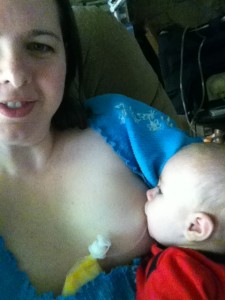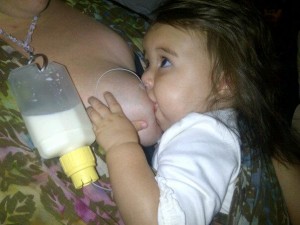
Used with permission.
“Maybe you just need to try a little harder.”
“Have you tried fenugreek?”
“You’re probably not drinking enough water.”
Mothers who struggle with milk production hear advice like this from well-meaning friends and family members (and sometimes, from breastfeeding supporters who should know better). While the vast majority of milk production problems can be remedied by addressing issues of breastfeeding management, there are some for whom making enough milk to sustain their babies is difficult or impossible. Called primary lactation failure, this condition occurs when a mother’s body does not make an adequate amount of milk for her baby, even when everything else (including but not limited to: latch and positioning, breastfeeding frequency and exclusivity, mother and baby are kept together, baby’s oral anatomy is fine – no tongue tie, cleft palate) is in order. Primary lactation failure can be due to a variety of factors, including previous thoracic or breast surgery that severs critical nerves or ductwork; hormonal complications, such as those that accompany polycystic ovarian syndrome or thyroid abnormalities; and a condition in which mammary tissue simply did not develop during adolescence. Called tubular (or tuberous) breast deformity in the plastic surgery literature, hypoplasia of the mammary gland (also called insufficient glandular tissue or IGT) was previously thought to be a simple issue of cosmetics – corrections addressed the appearance of a woman’s breasts, with little regard for their function. However, as breastfeeding gains significance as an issue of public health, more mothers seek to nourish their babies in this manner, but little is known about what to do when breastfeeding doesn’t work.
Why don’t some mothers make milk?
Lactation failure can be classified into three categories: preglandular, glandular, and postglandular (Morton, 1994). A preglandular cause for low or no milk production is directly related to hormonal issues such as a retained placenta or postpartum thyroiditis. Postglandular causes of insufficient milk production are those things that happen after the baby is born that get breastfeeding off to a “bad start,” like a baby who cannot properly transfer milk at the breast (for whatever reason), or poor breastfeeding management, such as scheduled feeds, extended separation of mother and baby. Glandular causes for low or no milk production can include previous breast surgery, or hypoplasia/IGT. Often, glandular lactation failure is accompanied by one or more preglandular and postglandular factors. Understanding your own body and health, asking questions about any medications or behaviors your doctor recommends during your pre-conception time, and being at a healthy body mass index (BMI) before becoming pregnant can help normalize your hormones. Expert breastfeeding assistance from an IBCLC, as well as choosing a birth setting that is Baby-Friendly, can help you ensure that breastfeeding gets off to the best start possible.
Now infants can get
all their vitamin D
from their mothers’ milk;
no drops needed with
our sponsor's
TheraNatal Lactation Complete
by THERALOGIX. Use PRC code “KELLY” for a special discount!
Do I have hypoplasia/IGT?

Image credit: Lisa Bartee
Hypoplastic breasts may be small or large. It is breast shape, placement, and asymmetry that indicate hypoplasia — not necessarily size. Normal-sized breasts that are lacking glandular tissue may be made up of fatty tissue that will sufficiently fill a bra cup.
In a study of 34 mothers by Huggins, Petok, & Mireles (2000), a correlation between the following physical characteristics and lower milk output was found:
- widely spaced breasts (breasts are more than 1.5 inches apart)
- breast asymmetry (one breast is significantly larger than the other)
- presence of stretch marks on the breasts, in absence of breast growth, either during puberty or in pregnancy
- tubular breast shape (“empty sac” appearance)
Additional characteristics that may indicate hypoplasia are:
- disproportionately large or bulbous areolae
- absence of breast changes in pregnancy, postpartum, or both
While a large percentage of mothers with IGT felt like their breasts were “different” or “something was wrong” during adolescence, it is usually not until pregnancy, when “the booby fairy doesn’t arrive” and her breasts change little or not at all, or after she has given birth, when she does not produce enough milk for her baby, that a mother knows she has insufficient glandular tissue. An exception to this might be if she sought or received breast augmentation surgery earlier in her life. Perhaps her plastic surgeon referred to “tuberous breast deformity” or “constricted breast,” both terms used to describe hypoplasia/IGT in the plastic surgery field.
It is important to consider that some mothers with the physical markers noted above have no trouble bringing in a full, normal supply of milk after giving birth. However, a prenatal breast assessment that reveals physical characteristics consistent with hypoplasia/IGT should prompt extra attention to getting breastfeeding off to the best start possible. As well, it can be especially foreboding if a mother does not notice any changes in her breasts during her pregnancy.
Why did this happen to me? Why can’t I make enough milk?

Image Credit: Lisa Bartee
It cannot be stressed enough that, if lactation failure of a glandular nature is suspected, preglandular and postglandular factors are accounted for and properly ruled out. It can be frustrating for a mother who really does have hypoplasia/IGT to keep being asked “have you tried X or Y,” but each well-intentioned care provider who asks such questions seeks to rule out the causes for low milk production that are far more common (and for which there are often effective fixes). As a clinician, I prefer to ask mothers “what measures have you tried, and what other possible causes for this have you explored?” This approach shows respect for the mother’s journey while also encouraging a full review of all of the factors that could contribute to the problem of insufficient milk production.
There is evidence (Rudel, Fenton, Ackerman, Euling, & Makris, 2011) to support a theory that exposure to high levels of certain environmental contaminants, namely dioxin and other endocrine disruptors, while in utero (exposure to accumulated contaminants in your mother’s body before you’re born) can predispose a woman to have insufficient breast growth during adolescence and pregnancy, the two times in her life her breasts should be growing. In some cases, a girl’s breasts may grow during puberty, but perhaps that growth is asymmetrical (uneven) or the breasts are large and appear normal, but only fatty tissue developed, not glandular tissue. This could be the result of hormonal irregularities that occur with some endocrine conditions, such as PCOS or uncontrolled thyroid or insulin-related conditions (Marasco, Marmet, & Shell, 2000). Some mothers with hypoplasia/IGT report luteal phase defect, which is a cyclical occurrence of lower-than-normal progesterone, even in the presence of ovulation. It is characterized by post-ovulatory basal body temperatures that do not rise significantly and may also result in pre-menstrual spotting. These cases of endocrine irregularities are especially important to address, because the hormone issues that interrupted the development of glandular tissue may also be preventing what milk-making tissue is there from doing its job. Normalizing these hormonal irregularities can help to maximize the performance of the glandular tissue that is present; this is why certain medications and herbs may have the effect of boosting milk production. However, what works for one mother might not work for another; this area needs more research.
What can I do now? I really wanted to breastfeed my baby.

Image Credit: Lisa Bartee
Some mothers, after taking measures to maximize their milk production, make peace with the situation quickly and find joy in bottle-feeding their babies with love and sensitivity. But, for the mother who envisioned breastfeeding as a vital part of her mothering experience, or the mother who is concerned with the risks of not providing human milk to her baby, the realization that her body isn’t going to produce what her baby needs to thrive can be devastating. Fortunately, there are ways to preserve aspects of the breastfeeding relationship. Again, it is imperative that all other potential causes of breastfeeding difficulty are ruled out, because any measure a mother takes to maximize and augment her milk production will be less effective if there are other factors at play, such as poor breastfeeding management or an inability on the baby’s part to effectively transfer milk. It is also vital to connect with other breastfeeding mothers and become familiar with the behavior of a normal breastfed baby; mothers who make plenty of milk worry that their babies aren’t getting enough when they’re fussy, if they feed often, or aren’t long sleepers. These aspects of normal newborn behavior may be especially unsettling to a mother with IGT, but a good understanding of what “normal” looks and acts like can smooth the process of re-developing trust in her own instincts about what her baby needs.

Photo credit: Nyssa Retter
Some mothers with hypoplasia/IGT are able to offer all feedings at their breasts, regardless of how much milk their breasts actually make, using an at-breast supplementing tool. This tool consists of a small tube that is taped beside or under the mother’s nipple; the tube is connected to a container that holds the supplement, which may be the mother’s own pumped milk, milk from a donor, or formula. Other mothers find that they are able to breastfeed and provide most of what their babies need, perhaps with the support of galactagogue (milk-making) herbs or medications, and only need to offer supplements, either at the breast or via bottle, once or twice each day. Your baby might be happiest if you offer an ounce by bottle, then latch him on to your breast once the edge has been taken off his hunger, and let him finish at your breast. Some mothers with hypoplasia/IGT find that their babies need no additional donor milk or formula supplementation around the middle of the first year, when they’ve shown readiness for some solid foods. One ounce of formula offers 20 calories; one ounce of mashed, ripe avocado provides 50 calories; banana and sweet potato each have 25 calories per ounce. Depending on your baby’s weight gain and supplementation needs, nutrient-dense foods may provide adequate nourishment alongside the milk you are able to produce. Your pediatrician can help you determine what is best for your baby.
The important thing is that you allow yourself the freedom to mourn the loss of the breastfeeding relationship you thought you would have. In that process, identify what aspects of breastfeeding your baby you were most excited to experience, and seek out the help of an IBCLC with experience in supporting mothers with low milk production or IGT. Help your IBCLC help you – do you want to learn how to pump and bottle-feed as much milk as you’re able to make? Does the at-breast supplementer that just came in the mail confuse you, and you need some help getting going with it? Maybe the idea of using milk donors appeals to you, but you want some more information before you move forward with that. Talk to your IBCLC about the lengths you’re willing to go to, and your comfort level with your situation. If she knows what your goals are, she can help you design a care plan that will suit your needs and your lifestyle. With support, many mothers go on to achieve their goals and have successful, fulfilling breastfeeding experiences that are about much more than the ounces of milk they produce.
References
Huggins, K., Petok, E., & Mireles, O. Markers of lactation insufficiency: a study of 34 mothers. Current issues in clinical lactation 2000; 25-35.
Marasco, L., Marmet, C., & Shell, E. (2000). Polycystic ovary syndrome: a connection to insufficient milk supply? Journal of Human Lactation, 16(2), 143-148.
Morton, J. A. (1994). The clinical usefulness of breast milk sodium in the assessment of lactogenesis. Pediatrics, 93, 802–806.
Neifert, M. R., Seacat, J. M., & Jobe, W. E. (1985). Lactation failure due to insufficient glandular development of the breast. Pediatrics, 76(5), 823-828.
Rudel, R. A., Fenton, S. E., Ackerman, J. M., Euling, S. Y., Makris, S. L. (2011). Environmental exposures and mammary gland development: State of the science, public health implications, and research recommendations. Environmental Health Perspectives 119(8): doi:10.1289/ehp.1002864
West, D., & Marasco, L. (2008). The Breastfeeding Mother’s Guide to Making More Milk. New York: McGraw-Hill.
Resources

Image Credit: Lisa Bartee
Books:
West, D., & Marasco, L. (2008). The Breastfeeding Mother’s Guide to Making More Milk. New York: McGraw-Hill. Website: http://lowmilksupply.org
Jacobson, H. (2004). Mother Food for Breastfeeding Mothers.
Humphrey, Sheila. (2003). The Nursing Mother’s Herbal. Minneapolis: Fairview Press.
On Facebook: IGT and Low Milk Supply Support Group
Online Community: MOBI (Mothers Overcoming Breastfeeding Issues)
Blog: Diary of a Lactation Failure
Website: Not Everyone Can Breastfeed
Articles:
Insulin resistance and lactation insufficiency: FAQ by Diana Cassar-Uhl, MPH, IBCLC
Milk supply mystery? Could it be insufficient glandular tissue?
Podcasts:
General Articles at KellyMom:
Tools for Feeding: Alternative Feeding Methods – Bottles & More
About the author:
Diana Cassar-Uhl, IBCLC and La Leche League Leader, is a frequent contributor to Breastfeeding Today and is the author of La Leche League’s “Vitamin D, Your Baby, and You” information sheet. She graduated with a Master of Public Health in 2013. Diana enjoys speaking at breastfeeding education events. She blogs about normalizing breastfeeding in American culture at http://DianaIBCLC.com, and is the author of “Finding Sufficiency: Breastfeeding with Insufficient Glandular Tissue,” which was published by Praeclarus Press in July of 2014. Mother to Anna, Simon, and Gabriella, Diana spent 17 years as a clarinet player on active Army duty with the West Point (NY) military band.
